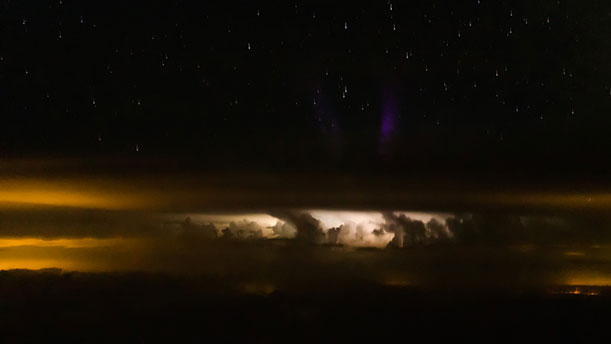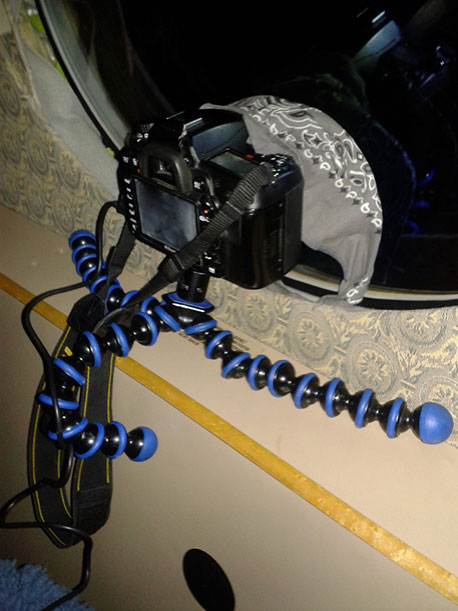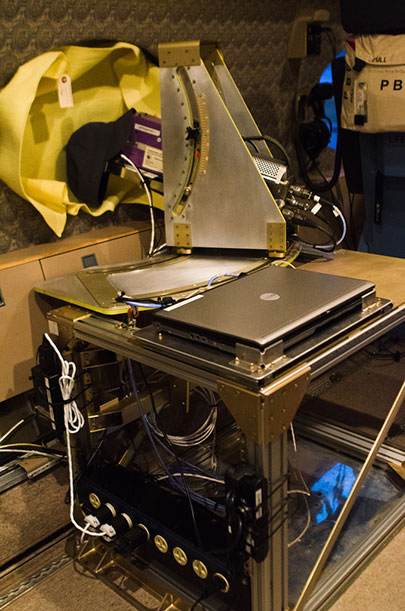Scientists Capture Rare Photographs of Red Lightning
Graduate student Jason Ahrns and colleagues hunt the skies for sprites—fleeting streaks and bursts of color that can appear above thunderstorms
/https://tf-cmsv2-smithsonianmag-media.s3.amazonaws.com/filer/Collage-Red-Lightning-631.png)
Jason Ahrns, a graduate student at the University of Alaska-Fairbanks, and other scientists from the U.S. Air Force Academy and Fort Lewis College—all part of a project sponsored by the National Science Foundation—have been on a mission. This summer, the group has taken to the skies in the National Center for Atmospheric Research’s Gulfstream V research aircraft, logging a total of 30 hours over multiple flights, in search of sprites.
Sprites, also known as red lightning, are electrical discharges that appear as bursts of red light above clouds during thunderstorms.Because the weather phenomenon is so fleeting (sprites flash for just milliseconds) and for the most part not visible from the ground, they are difficult to observe and even more difficult to photograph, rather like the mischievous air spirits of the fantasy realm that they’re named for. Ahrns and his colleagues, however, have captured extremely rare photographs of the red lightning, using DSLR cameras and high speed video cameras positioned in the plane’s window. The researchers hope to learn more about the physical and chemical processes that give rise to sprites and other forms of upper atmospheric lightning.
What’s it like to capture images of some of nature’s most short-lived and erratic features? I questioned Ahrns over email, and he explained what sprites are, why they occur, how scientists find them and why he’s so interested in the elusive phenomena.
First of all, what is a sprite?
A sprite is a kind of upper atmosphere electrical discharge associated with thunderstorms. A large electric field, generated by some lightning strokes, ionizes the air high above the cloud, which then emits the light we see in the pictures. They obviously beg comparison to the regular lightning bolts we see all the time, but I like to point out that the sprites are much higher, with the tops reaching up to around 100 kilometers, and higher. A lightning bolt might stretch around 10 kilometers from the cloud to the ground, but a sprite can reach 50 kilometers tall.
A “jellyfish” sprite captured over Republic County, Kansas, on August 3, 2013. Image courtesy of Jason Ahrns via Flickr.
Under what conditions do they occur?
They’re associated with positive lightning strokes, which is when the cloud has a buildup of positive charge and releases a bolt of lightning. Negative strokes, from a buildup of negative charge, are about 10 times more common, so sprites aren’t strongly associated with the most common kind of lightning, but it’s not really that uncommon either. More than just a positive stroke, the more charge that was moved during the stroke, the better the chances for a sprite. So we look for a large positive charge-moment-change, which is basically the positive strokes weighted by how much charge was moved. Most large thunderstorms seem to produce the conditions that lead to sprites, but some more than others. We just look for a storm with a history of lots of large positive charge-moment-change and go look at it.
What’s your scientific background? And how did you get interested in sprites?
I’m primarily an aurora researcher, that’s what I’m doing my thesis on at UAF. I got involved in sprites because one of my graduate committee members is organizing these campaigns and needed some extra help. I thought sprites were fascinating, and my advisor was supportive of me branching out a bit, so I hopped aboard the team.
Sprites over Red Willow County, Nebraska, on August 12, 2013. Image courtesy of Jason Ahrns via Flickr.
From what I understand, not much is known about red lightning, discovered just 25 years or so ago. With the NSF project, what are you and the other scientists hoping to learn? What are the biggest questions you have?
With this campaign we’re focusing on three questions. First, what basic physical and chemical processes are occurring? It’s still not clear what exactly is happening in a sprite, and why there are different kinds of sprites, and what conditions give you a column sprite vs. a carrot sprite, for example. (All the sprite names just refer to their shape.) Next, do sprites have a large scale impact on the middle atmosphere? Sprites clearly represent some kind of transfer of energy, but is it on a scale that has a significant effect on the weather and climate? We can’t answer that without studying them. And, then, what can we learn about basic streamer physics? The tendrils coming off the bottom of the sprites are ‘streamers’—little balls of ionization—moving about. Streamer speed and lifetime is related to air density, so studying sprites in the very low density upper atmosphere is like looking at streamers with a magnifying glass in slow motion, though they’re still quite fast!
How many sprite-hunting missions have you been on?
Personally, this is my second aerial campaign. The first, in 2011, flew a total of 40 airborne hours, and this campaign did another 30 hours. It’s probably around 15ish total flights. The same crew, minus me, did one other aerial campaign in 2009.

Ahrns captured these blue jets, which look like flames from a butane lighter, over Republic County, Kansas, on August 3, 2013. Unlike sprites, blue jets aren’t directly triggered by lightning, but seem to be somehow related to the presence of hail storms. Image courtesy of Jason Ahrns via Flickr.
What conditions, times of the day, areas of the country and altitudes are ideal for these flights?
The midwest is productive, mostly because it gets these powerful thunderstorms that last all night. Obviously, we need it to be dark, but other than that the time of night doesn’t seem to matter much, only how strong the storm is and how much powerful positive lightning it’s producing. We do notice that when the storm is going good it produces the column sprites and carrot sprites, but as it dies off it seems to switch over to less frequent, but bigger and brighter, jellyfish sprites. We fly as high as we can get, usually between 41,000 and 45,000 feet, but that’s simply to get a view over the clouds. We’re still below the sprites.
The lightning lasts just milliseconds, so I’m especially curious about how you photograph it. What equipment do you use?
For the still photographs, I just set my camera (a Nikon D7000 and a fast lens) facing out the window and set an intervalometer so the camera just constantly snaps pictures. Then I go through later and delete everything that doesn’t have a sprite in it. It’s the same principle as lightning photography; it seems like you’d have to get the timing just right but it’s really just statistical, if you snap a bunch of pictures one of them is going to get something sooner or later. I probably snap on the order of 1,000 pictures for every sprite I come away with.
For the high speed video cameras, the camera has a buffer that constantly cycles through the previous however many frames of video, and when I see a sprite I hit a trigger that tells the camera to stop and save whatever it just recorded. When we’re running at 10,000 frames per second, the buffer fills up in about a second, so that’s how long I have to recognize a sprite and hit the button. This can be pretty taxing on a slow night when you have to watch nothing happen for 45 minutes straight and still be ready with that less than one second reaction time.
Can you describe the setup? How do you actually take photographs from the plane window?
A picture is worth a thousand words, right?

Ahrns’s setup near the plane’s window. Image courtesy of Jason Ahrns via Flickr.
And for the high speed video…

His setup for capturing high speed video. Image courtesy of Jason Ahrns via Flickr.
We have an internet connection aboard the plane so we can watch weather conditions in real time. We just point the above cameras at the most productive looking part of the storm and wait for sprites.
How rare are photos like these that you have taken?
As far as I can tell, they’re pretty rare. There are some sprite images taken with meteor cameras and webcams out there, but they’re usually low resolution due to being very far away and using a wide angle lens. I’ve seen two or three sprite images taken with a DSLR, but they’re still from the ground and a good distance away, and usually shots of something else that got lucky with a sprite in the background. I have the advantage of being up in the air, close to the sprite producing region, with a good guess of where the sprites will appear, so I can use a lens with a narrower field of view to capture the sprite up close.
As for the images I got of blue jets, as far as I can tell they’re actually the first images of jets taken with a DSLR. That makes some sense, because the jets are a lot closer to the top of the clouds than sprites so much harder to see from the ground. Being in the air is a major advantage.
Taken over Red Willow County, Nebraska, on August 12, 2013. Image courtesy of Jason Ahrns via Flickr.
What do you find artful about the images, if anything?
I think there’s a really otherwordly starkness about them. Take this one (above), for example. You’ve got this nice serene starfield, and some cool, calming blue light coming up from the lightning below. Then BLAM! This weird, menacing, totally alien looking sprite just takes over the whole scene, like ‘I’m here, what are you gonna do about it?’
Hans Nielsen, the principal investigator on the campaign (and my previously mentioned committee member), says this one (below) reminds him of the classic Dutch paintings, with its sepia tones and slight blurring from the atmospheric haze.
Taken over Canadian County, Oklahoma, on August 6, 2013. Image courtesy of Jason Ahrns via Flickr.
What have you learned thus far about sprites by participating in this project?
Personally? When I joined the 2011 campaign I knew nothing about sprites beyond the Wikipedia entry. I learn more every night of the campaigns, listening to the others talk about conditions beforehand, what we’re seeing during the flights and our ‘what we did right, what we did wrong’ discussions over post-flight beer. I’m still a newbie compared to the other guys, but I’m now at the point where I can field most general public questions about sprites and sprite hunting.
Where and when are you flying next?
Nothing is set in stone, but we’d really like to fly again next summer. Hopefully we can make that happen.
/https://tf-cmsv2-smithsonianmag-media.s3.amazonaws.com/accounts/headshot/megan.png)
/https://tf-cmsv2-smithsonianmag-media.s3.amazonaws.com/accounts/headshot/megan.png)